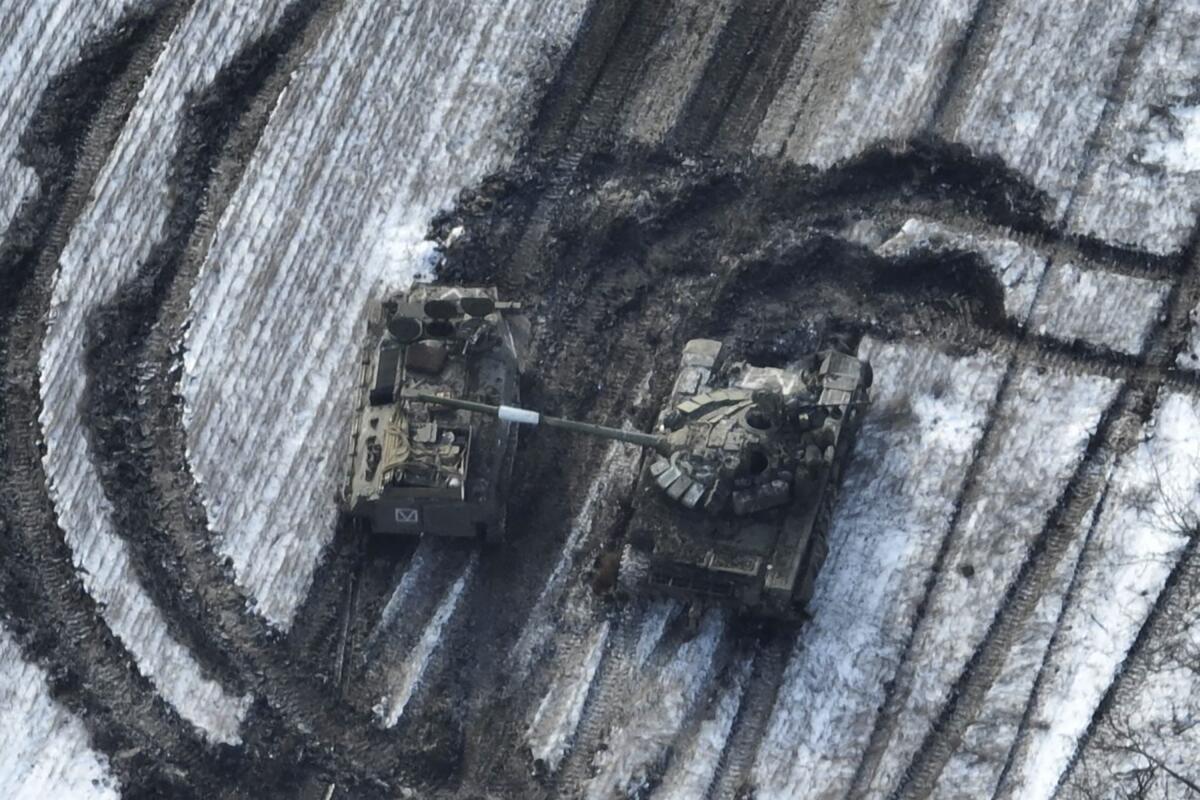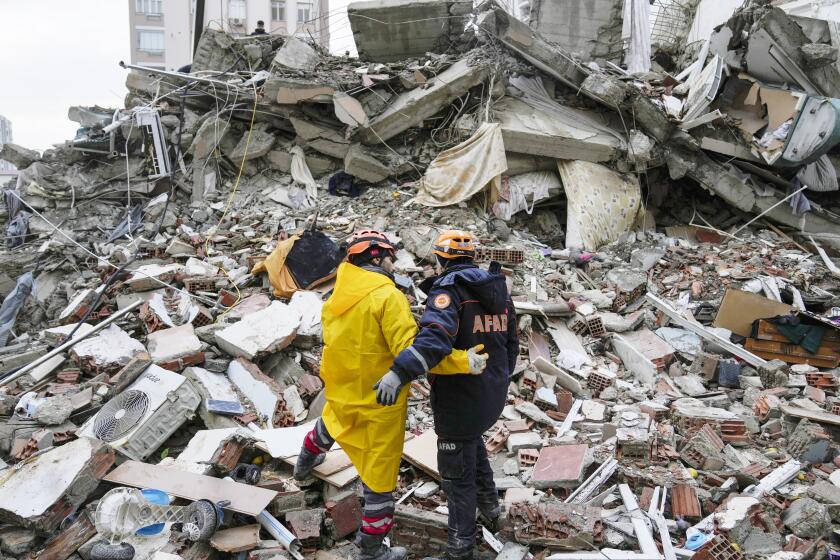Hilltop coal-mining town a tactical prize in Ukraine war

- Share via
KYIV, Ukraine — In a small coal-mining town on Ukraine’s eastern front line, a fight for strategic superiority is being waged in a battlefield steeped with symbolism as the one-year anniversary of Russia’s invasion nears.
The town of Vuhledar — meaning “gift of coal” — has emerged as a critical hot spot in the fight for Donetsk province that would give both sides, the Ukrainian forces who hold the urban center, and the Russians positioned in the suburbs, a tactical upper hand in the greater battle for the Donbas region.
On an elevated plane that is one of the few high-terrain spots in the area, its capture would be an important step for Russia to disrupt Ukrainian supply lines. Securing Vuhledar would give Ukraine a potential launching pad for future counter-offensives south.
Then there is the symbolic weight: Vuhledar is close to the administrative border of Donetsk province, and winning it would play into Russia’s greater aim of controlling the region as a whole.
“The center of gravity of the Russian military effort is in Donetsk, and Vuhledar is basically the southern flank of that,” said Gustav Gressel, a senior policy fellow with the European Council on Foreign Relation’s Berlin office.
The flaws of non-ductile concrete construction are found across California, with many buildings having not been evaluated or retrofitted and at risk of collapse in a serious earthquake.
The grinding fight to win the area has cost Russia manpower and weapons, as Ukrainians continue to hold up defensive lines. Russia sends battalion-sized scout groups to probe Ukrainian lines and shoot artillery toward their positions with an eye to pushing north toward the critical N15 highway, a key supply route.
In remarks this week, Russian Defense Minister Sergei Shoigu said Russian troops were advancing “with success” in Vuhledar. Meanwhile, a British defense intelligence briefing said Russia’s aim was to capture unoccupied areas of Ukrainian-held Donetsk but it was unlikely to build up the forces required to change the outcome of the war.
Vuhledar’s pre-war population of 14,000 has dwindled to about 300. The majority of the town’s residents worked in the coal mine and nearby factories before the war.
Olha Kyseliova, who was recently evacuated, worked in a brick factory before the fighting upended her life.
Russian forces ramped up attacks beginning Jan. 24, residents said. That day, a missile tore through Kyseliova’s nine-story building. She was sheltering in the basement with her three children and emerged to find a gaping hole through the roof of her third-floor apartment.
That was the moment she decided she had to leave her hometown. “I cried the entire way out, I didn’t want to leave,” she said.
Three Ukrainian brigades are positioned in Vuhledar and on the outskirts of the town. The Associated Press spoke to five commanders in units from all three, who provided only their first names in keeping with Ukraine’s military policy. Russia’s 155 Marine infantry troops are positioned just two miles away in Vuhledar’s suburbs.
For both sides, the town is tactically important.
“It’s one of the main logistics points of the Donbas region, and also one of the main points of elevation,” said Maksym, the deputy commander of a Ukrainian marine infantry battalion. “By capturing Vuhledar, Russians can easily occupy the entire Donetsk region.”
Seizing Vuhledar would enable Russia to push forward and threaten Ukrainian supply lines feeding into the fierce Marinka front line to the north, said Gressel of the European Council on Foreign Relations. For Ukraine, Vuhledar would be a launching pad for future counter-offensives toward Mariupol and Berdiansk.
From their perch in the town, Ukrainian forces can see into Russian lines and have so far been able to repel Russian attempts to encircle Vuhledar. Columns of Russian tanks and armored vehicles transporting infantrymen continuously assault and attempt to break Ukrainian defenses. Aviation, rockets and artillery target the town.
“But with our fighters and anti-tank equipment their attempts have not been successful,” said Maksym, the Ukrainian deputy commander. “The situation is strained, but controlled.”
Similar to other front lines along the east, the Russians are losing scores of infantrymen in an attempt to tire and weaken Ukrainian defensive lines. Serhii, the commander of a Ukrainian intelligence unit, said he saw Russian soldiers sent straight through fields mined by the Ukrainians following Russia’s capture of the village of Pavlivka, south of Vuhledar, in November.
“They de-mine our fields by using their own people,” he said.
Ukrainian commanders said some of their units are suffering from dire ammunition shortages.
That view was not shared across brigades, suggesting some are better supplied than others. Taras, the commander of a mortar unit, said his forces were suffering very serious shortages. Faced with orders to target an enemy position, he said, “I have just two or three rounds of ammunition to do it. It’s nothing.”
Two commanders of a brigade inside Vuhledar reported the Russians hurled gas-laden projectiles that caused severe disorientation for hours, and burning of the throat and skin. Higher-ranking commanders did not comment on the type of gas used and said an investigation was ongoing.
“They are probing and testing us across the eastern front line, including in Vuhledar,” said Oleksandr, a commander who was recently rotated out of the town. “They are trying to find our points of weakness.”
For now, Russia’s activities around Vuhledar are not “operationally significant,” said Kateryna Stepanenko, a Russia analyst with the U.S.-based think tank Institute for the Study of War. More combat power is required to execute breakthroughs that would achieve the stated aim of the Russian invasion — the capture of the entire Donetsk province.
Even in the event of victory in Vuhledar, Russia would still need a lot of combat power to push north. Three months after capturing the village of Pavlivka in November, Russian forces have yet to make breakthroughs in Vuhledar, which is only a six-minute drive away.
“It’s not operationally significant because Russians will still have to fight for more territory to make a meaningful disruption of Ukrainian ground lines of communication to western Donetsk,” Stepanenko said. Vuhledar is just “one settlement on their way, where they are already suffering significant losses and where they already seem to have suffered losses in the area before.”
Meanwhile, the last of Vuhledar’s residents said they are staying put.
Oleksandra Havrylko, police press officer for the Donetsk region, pleads with those who remain to leave the devastated area. Most spend their days hiding in basements, coming out when there are lulls in fighting to charge phones and gather supplies in the town’s points of refuge, called “invincibility centers.”
All but one of the town’s children have been evacuated. The father of a 15-year-old, the last remaining minor in the town, refuses to part with his son or leave the area, she said.
“There are people in the city who don’t want to be evacuated, we tried many times,” she said. Most have never ventured far from their hometown.
More to Read
Sign up for Essential California
The most important California stories and recommendations in your inbox every morning.
You may occasionally receive promotional content from the Los Angeles Times.











